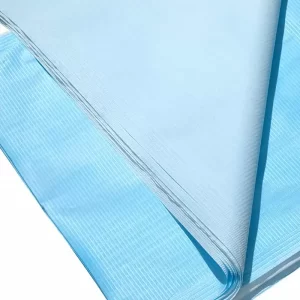Disposable bed pads, also known as underpads or incontinence pads, play a crucial role in maintaining hygiene and comfort in healthcare facilities, elderly care settings, and home environments. These non-reusable pads are designed to absorb fluids and protect bedding from contamination, ensuring a cleaner and healthier environment for individuals with incontinence, post-operative recovery, and other conditions.
Benefits of Disposable Bed Pads
- Enhanced Hygiene: Disposable bed pads effectively absorb urine, feces, and other bodily fluids, preventing the spread of pathogens and minimizing the risk of infection.
- Improved Comfort: The absorbent materials used in these pads provide a soft and dry surface for individuals, promoting their well-being and preventing discomfort associated with wetness.
- Convenience and Time-Saving: Disposable bed pads eliminate the need for frequent laundry, saving time and effort for caregivers and healthcare professionals.
- Odor Control: Some disposable bed pads incorporate odor control technology to effectively neutralize unpleasant smells, ensuring a more hygienic environment.


Types of Disposable Bed Pads
Disposable bed pads are available in a variety of sizes, absorbency levels, and materials to meet specific needs:
- Single-Use Pads: Designed for one-time use, these pads are typically lightweight and economical.
- Reusable Pads: Made from more durable materials, reusable pads can be washed and reused multiple times, providing a more environmentally friendly option.
- Plastic-Backed Pads: These pads feature a waterproof plastic backing to prevent moisture from seeping through to the bedding.
- Quilted Pads: Quilted pads offer a more comfortable surface and better wicking of fluids.
- Fitted Pads: Designed to fit specific bed sizes, fitted pads provide a secure and discreet protection.
Choosing the Right Disposable Bed Pad
When selecting disposable bed pads, consider the following factors:
- Absorbency: Choose pads with an absorbency level appropriate for the individual's needs.
- Size: Select pads that are large enough to cover the necessary area and provide adequate protection.
- Material: Choose pads made from soft and comfortable materials that minimize irritation.
- Additional Features: Consider pads with features such as odor control, leak guards, or other enhancements that meet specific requirements.
Using Disposable Bed Pads Effectively
To maximize the benefits of disposable bed pads, follow these tips:
- Place the pad under the individual's hips and buttocks.
- Change the pad frequently, especially after each episode of incontinence.
- Dispose of used pads in a designated receptacle.
- Wash hands thoroughly after handling used pads.
Conclusion
Disposable bed pads are an essential tool for maintaining hygiene and comfort in various healthcare and home settings. By choosing the right type and using them effectively, healthcare professionals and caregivers can ensure the well-being of individuals and promote a healthier environment.
